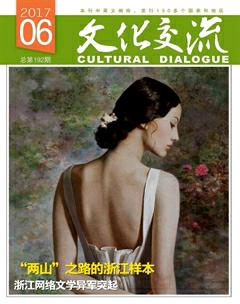天台和合小镇:绿水青山一根藤
米奥
几乎每个天台人,都懂得“和合”二字的涵义。千余年来,和合文化已经深深融入天台的社会生活当中。它源于天台,而广泛传向全国。
如今,一个讲述中国和合文化故事的天台和合小镇,在绿水青山间铺设开来。
和合文化的来源
说起和合文化,绕不开传说中的和合二仙。两位短发齐眉、憨态可掬的少年,一人手捧礼盒,一人肩扛荷花,温馨祥和、亲密无间。天台人对这幅景象最熟识不过了,这二人便是和合二仙的原型——寒山、拾得。
唐朝时期,天台山出现了两位方外传奇人物——寒山、拾得,佛教称他们为“和合佛”,道教称他们为“和合二仙”,儒教奉他们为“和合二圣”。称谓虽不同,却同样饱含“贵和尚中、善解能容,厚德载物、和而不同”的寓意。
民间传说,国清寺举行法会,越州汪老太太和女儿芙蓉赴会。老太太因旅途劳累倒在寺中,寒山、拾得为其治病。虽因病情太重不久于人世,但为感谢两位,老太太立下遗嘱,将女儿许配给两人中的任何一人。
处理完老太太后事,寒拾两人互相推让。寒山悄然出走。拾得也放弃婚姻,出外寻访挚友。最后,在苏州寒山寺,拾得找到了寒山。兄弟相见,寒山和拾得分别以盛着素斋的竹盒和红艳的荷花相赠,并一起住在了古寺内。后来,人们称拾得为“和(荷)仙”,寒山为“合(盒)仙”。
和合二仙,寄托了百姓对和乐美满生活的向往,体现了人们对“朋友和合”、“夫妻和合”的寄寓。如今,和合二仙与丰干一起,被供奉在国清寺的三贤殿内。在天台,两位神仙亦常见于婚嫁喜庆场合的中堂,被称为喜庆之神。
除传说外,天台和合文化还有另一说法。早在汉代,儒学大家高察、顾欢等人在天台设馆课徒,带来了儒家的“和合”理念。汉武帝时期,闽越发动对瓯越的战争,天台一度成为“虚地”。自东晋至南宋,天台曾有三次移民大潮,移民们来自不同地方,不同家庭姓氏的人群聚居于此,为了避免引发一些矛盾和摩擦,更加懂得“和合”的重要与可贵。此后,和合文化贯穿天台生活百态。
如今,为将和合文化流芳百世,天台打造了以非物质文化遗产和养生文化传统为特色的和合小镇。和合文化,便是和合小镇的灵魂。
一根藤的坚守
徜徉在天台古民居中,总会看见由藤条演化而成的木窗花装饰,委婉多姿,呈现的都是圆满、吉祥的意蕴。它们,被称为“一根藤”。
用手顺着藤慢慢摸去,无论起点从何处开始,手指终会绕回原点,这便是一根藤。一根藤与和合文化天然契合,演绎出一段传奇的故事。
一根藤是台州市级“非遗”项目。大到祠堂庙宇、富裕人家的门窗、屏风,小到寻常人家的凳子、镜框,随处可见。绵延不断的藤蔓,寓意常青不老。吉祥图腾,寄托着民间对美好生活的期盼。
沈中明,原本经营一家汽车内饰品生产公司,拥有天台山风景区的30多亩地、5幢厂房。七八年前,由于城市规划的需要,老厂房面临废弃。因为不舍老厂房化作灰烬,热爱文化的沈中明决定将这里改建成文化园。恰逢儿子沈盛钢从英国留学归来,父子二人达成默契,踏上了收集一根藤的寻访之路。
然而,因制作工艺复杂,工时长,目前保留完好的一根藤不常见,寻访之旅注定艰辛。这些年,父子二人的足迹像极了山间攀援游走的藤,用脚步丈量天台的大小村庄,也曾漂洋过海,终于收录大大小小200余件一根藤。
沈盛钢的工作室,就坐落在“和合人间”文化园中,位于小镇的中心区。走进去,只见六七位匠人神情专注地端坐在工作台前,凿孔、锯圆。他们是天台仅有的一根藤匠人,因执着于文化传承在此相聚。
制作一根藤,需经过打样、取材、刨条、凿孔等20多道工序,其中最难的是榫头的衔接,弯曲度大的回弯需要五六个榫头。匠人要有扎实的基本功,还得有艺术家的素养,根据不同的条件和要求进行独家设计。
老匠人最担心的是一根藤手艺即将失传。如今,现代组合家具兴起,使得费时费力成本又高的一根藤日渐式微,匠人们纷纷转行。老匠人希望借着和合小镇的建成,复兴这一传统工艺。目前,文化园中已有一些年轻人在学习一根藤技艺。
一根藤圆满、吉祥的寓意,与和合文化十分契合。和合文化,体现在一根藤沧桑的纹理中。而不仅是一根藤,待小镇建成后,天台近200个“非遗”项目,将在此迎来传承的新机遇。
小镇的远方
驱车驶往县城北郊天台山,便是和合小鎮。
小镇处于“低丘浅谷”的景胜之间,四周山体巍峨,植被郁郁葱葱。一条名为“赭溪”的清澈小溪贯穿流过,为小镇增添了一抹灵动的气息。
便利的交通,为和合小镇引来了源源不断的车流和人气。有风尘仆仆赶来的香客,有爱好和合文化的学者,也有前来一睹天台山秀丽风光的游人。
在小镇,和合文化彰显于布局中。自东向西,由“静谧”向“动感”过渡,是和合文化中“出世”与“入世”的隐喻表达。和合文化中心区便是小镇的客厅,既可以看到中华佛教城、“和合人间”文化园、天台县博物馆,了解博大精深的天台山文化,也可信步至附近的旅游特色村,体会乡土民情。疲乏时,还可到天台山温泉度假山庄去泡一个舒服的温泉。
西面,集散中心已初具规模。新中式风格的建筑鳞次栉比,错落有序。而拆迁的东升村、赤义村的安置房建设正在展开,这无疑让周边的百姓有了发展民宿的机遇。
集散中心周边,天台计划依托黄眉奥、西牧场、大湾三个水库,以及周边山体,布置四处生态休闲游憩区。同时,通过区域内居民原址进行整改,将出现松门、墙头曹两个旅游特色村。越来越多的村民将搭上旅游发展的快车。
这两年,借着打造和合小镇的背景,失传已久的天台“非遗”项目一根藤,经过沈氏父子的收集与传承,正在逐步走上产业化的发展道路。沈氏父子除了致力于构建一根藤展示馆以及茶之路体验馆等,由一根藤的艺术元素衍生开来的手机挂件、家居装饰等的生产,也在紧密筹谋之中。
2016年2月,和合小鎮被列入浙江省第二批特色小镇创建单位。目前,小镇内的山庄、酒店和博物馆等多个项目已建成开放,今后将有更多项目启动,比如通用机场将入驻小镇,台州首家航空体验中心落户于此。
以山水神秀的和合小镇为契机,天台添上了浓墨重彩的一笔。
(本文照片由作者提供)
‘Harmony Town in Tiantai
By Mi Ao
The profound connotations of ‘和 (meaning harmony, pronounced roughly like “her” in English) in the Chinese language are not easy to grasp, but almost everyone in Tiantai, one of the ‘holy lands of Chinese Buddhism and the unique Chinese ‘harmony culture, knows its unfathomably deep cultural and philosophical meanings. In Tiantai, a county in Zhejiang, the ‘harmony philosophy is infused into peoples everyday life and is crystallized in a newly developed town nestling at the foot of the Tiantai Mountain in the countys scenic western outskirts.
Legend has it that the founders of Chinas ‘harmony culture are two celestial beings living in the Tiantai Mountain in the Tang Dynasty (618-907) and are revered by the locals as Hanshan and Shide. However, opinions about the origin of the ‘harmony culture of Tiantai vary.
In fact, the name ‘Tiantai is derived from the fact that Zhiyi, the fourth patriarch, lived on todays Tiantai Mountain. Zhiyi is also regarded as the first major figure to make a significant break from the Indian tradition, to form an indigenous Chinese system. Tiantai is sometimes also called “The Lotus School”, after the central role of the Lotus Sutra in its teachings. During the Tang dynasty, the Tiantai school became one of the leading schools of Chinese Buddhism, with numerous large temples supported by emperors and wealthy patrons, with many thousands of monks and millions of followers.
It is also believed by some experts that the culture is originated in the times of Confucianism master Gao Cha and Gu Huan who lived in the Han period (202BC-220AD) of China. From the start of the warring years in the Han Dynasty all the way down to Jin and Southern Song years, Tiantai became a ‘refugee camp. People from all over the country moved in just to survive the warring chaos. There are good reasons to believe that ‘harmony has since been cherished by these immigrants and grew to be the core value of the local culture.
The traditional Tiantai-style civilian architecture features window decoration that uses the unique rattan craftsmanship well-conserved by the locals. Such decoration, known by the locals as ‘yi gen teng (literally ‘a piece of rattan), has been a long-time tradition and bears various auspicious connotations. The craftsmanship, that can be relished almost everywhere the eye could see in Tiantai – from ancestral halls, temples to the doors, windows, stools and picture frames of an ordinary household, is also valued as a Tiantai cultural heritage that is now under city-level protection.
A major player in the conservation of the unique cultural treasure is a cultural park run by Shen Zhongming and his son Shen Shenggang, who has just finished his study in the UK. Also a part of the ‘Harmony Town, the cultural park is a remake of old factory buildings. In Shens rattan studio, people can feast their eyes on the rattan artistry displayed by local craftsmen who are the patron saints of the endangered craft.
Traversed by a babbling brook and surrounded by lush, undulating mountains, the lovely valley area is a fitting place for the development of a tourist destination that targets pilgrims of Chinas ‘harmony tradition. The town center serves as the ‘living room, where tourists can peruse an array of cultural spots such as China Buddhism Park, ‘Harmony Culture Park and Tiantai Museum for a first-hand experience of the countys cultural riches and Buddhism appeal.
For a relaxed end of the trip, one can spend a night or two at the Tiantai Mountain Hot Spring Resort and stop at a lovely village nearby for a glimpse of the local life. Dongsheng Village and Chiyi Village also have a few folk house ‘bed and breakfast options for backpackers to choose from.
Future development of the town will include a recreational area surrounding the tourist center. The project will draw scenic and cultural resources from three reservoirs and two villages nearby. Many other facilities in the town, including a hotel and a museum, are now open to the public. The first aviation experience center in Taizhou will also be based here.

